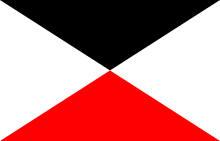XVIII Reserve Corps (German Empire)
| XVIII Reserve Corps XVIII. Reserve-Korps | |
|---|---|
|
Flag of the Staff of a Generalkommando (1871–1918) | |
| Active | 2 August 1914 - post November 1918 |
| Country |
|
| Type | Corps |
| Size | Approximately 38,000 (on formation) |
| Engagements | |
The XVIII Reserve Corps (German: XVIII. Reserve-Korps / XVIII RK) was a corps level command of the German Army in World War I.
Formation
XVIII Reserve Corps was formed on the outbreak of the war in August 1914[1] as part of the mobilisation of the Army. It was initially commanded by Generalleutnant Kuno von Steuben, formerly of the Prussian War Academy.[2] It was still in existence at the end of the war[3] in the 18th Army, Heeresgruppe Deutscher Kronprinz on the Western Front.[4]
Structure on formation
On formation in August 1914, XVIII Reserve Corps consisted of two divisions, made up of reserve units. In general, Reserve Corps and Reserve Divisions were weaker than their active counterparts
- Reserve Infantry Regiments did not always have three battalions nor necessarily contain a machine gun company[5]
- Reserve Jäger Battalions did not have a machine gun company on formation[6]
- Reserve Cavalry Regiments consisted of just three squadrons[7]
- Reserve Field Artillery Regiments usually consisted of two abteilungen of three batteries each[8]
- Corps Troops generally consisted of a Telephone Detachment and four sections of munition columns and trains [9]
In summary, XVIII Reserve Corps mobilised with 24 infantry battalions, 5 machine gun companies (30 machine guns), 6 cavalry squadrons, 12 field artillery batteries (72 guns) and 3 pioneer companies. It included one active Infantry Regiment (168th).
| Corps | Division | Brigade | Units |
|---|---|---|---|
| XVIII Reserve Corps[10] | 21st Reserve Division | 41st Reserve Infantry Brigade | 80th Reserve Infantry Regiment |
| 87th Reserve Infantry Regiment[11] | |||
| 42nd Reserve Infantry Brigade | 81st Reserve Infantry Regiment[12] | ||
| 88th Reserve Infantry Regiment | |||
| 7th Reserve Dragoon Regiment | |||
| 21st Reserve Field Artillery Regiment | |||
| 4th Company, 11th Pioneer Battalion | |||
| 21st Reserve Divisional Pontoon Train | |||
| 17th Reserve Medical Company | |||
| 25th Reserve Division | 49th Reserve Infantry Brigade | 116th Reserve Infantry Regiment | |
| 118th Reserve Infantry Regiment[13] | |||
| 50th Reserve Infantry Brigade | 168th Infantry Regiment | ||
| 83rd Reserve Infantry Regiment | |||
| 4th Reserve Dragoon Regiment | |||
| 25th Reserve Field Artillery Regiment | |||
| 1st Reserve Company, 11th Pioneer Battalion | |||
| 2nd Reserve Company, 11th Pioneer Battalion | |||
| 25th Reserve Divisional Pontoon Train | |||
| 18th Reserve Medical Company | |||
| Corps Troops | 18th Reserve Telephone Detachment | ||
| Munition Trains and Columns corresponding to the III Reserve Corps |
Combat chronicle
On mobilisation, XVIII Reserve Corps was assigned to the 4th Army forming part of the centre of the forces for the Schlieffen Plan offensive in August 1914.
Commanders
XVIII Reserve Corps had the following commanders during its existence:[14][15]
| From | Rank | Name |
|---|---|---|
| 2 August 1914 | Generalleutnant | Kuno von Steuben[16] |
| 19 August 1914 | General der Infanterie | |
| 5 June 1917 | Generalleutnant | Karl von Wenninger |
| 11 September 1917 | Generalleutnant | Ludwig Sieger |
See also
References
- ↑ Cron 2002, p. 86
- ↑ The Prussian Machine Archived October 3, 2013, at the Wayback Machine. Accessed: 3 March 2012
- ↑ Cron 2002, pp. 88–89
- ↑ Ellis & Cox 1993, pp. 186–187
- ↑ Cron 2002, p. 111 About a third of Reserve Infantry Regiments formed in August 1914 lacked a machine gun company
- ↑ Cron 2002, p. 116 Active Jäger Battalions had a machine gun company with the exceptions of the 1st and 2nd Bavarian Jäger Battalions
- ↑ Cron 2002, p. 128 Most active cavalry regiments had four squadrons, some were raised to six squadrons
- ↑ Cron 2002, p. 134 Active Divisions had a Field Artillery Brigade of two regiments
- ↑ Cron 2002, p. 86 Active Corps Troops included a battalion of heavy howitzers (Foot Artillery), an Aviation Detachment, a Telephone Detachment, a Corps Pontoon Train, a searchlight section, 2 munition column sections, one Foot Artillery munitions column section and two Train sections
- ↑ Cron 2002, pp. 313–314
- ↑ Without a machine gun company
- ↑ Without a machine gun company
- ↑ Without a machine gun company
- ↑ "German War History". Retrieved 22 December 2012.
- ↑ "Armee-Reserve-Korps". The Prussian Machine. Archived from the original on April 11, 2012. Retrieved 22 December 2012.
- ↑ Promoted "Kuno von Steuben". The Prussian Machine. Archived from the original on October 3, 2013. Retrieved 22 December 2012.
Bibliography
- Cron, Hermann (2002). Imperial German Army 1914-18: Organisation, Structure, Orders-of-Battle [first published: 1937]. Helion & Co. ISBN 1-874622-70-1.
- Ellis, John; Cox, Michael (1993). The World War I Databook. Aurum Press Ltd. ISBN 1-85410-766-6.
- Histories of Two Hundred and Fifty-One Divisions of the German Army which Participated in the War (1914-1918), compiled from records of Intelligence section of the General Staff, American Expeditionary Forces, at General Headquarters, Chaumont, France 1919. The London Stamp Exchange Ltd (1989). 1920. ISBN 0-948130-87-3.
- The German Forces in the Field; 7th Revision, 11th November 1918; Compiled by the General Staff, War Office. Imperial War Museum, London and The Battery Press, Inc (1995). 1918. ISBN 1-870423-95-X.

